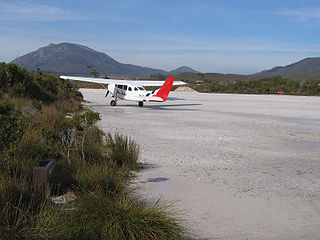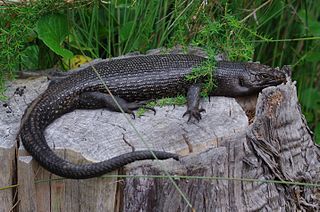
The frilled lizard, also known as the frill-necked lizard or frilled dragon, is a species of lizard in the family Agamidae. It is native to northern Australia and southern New Guinea. This species is the only member of the genus Chlamydosaurus. Its common names come from the large frill around its neck, which usually stays folded against the lizard's body. It reaches 90 cm (35 in) from head to tail and can weigh 600 g (1.3 lb). Males are larger and more robust than females. It is generally grey, brown, orangish-brown, or black in colour. The frills have red, orange, yellow or white colours.

Rear Admiral Phillip Parker King, FRS, RN was an early explorer of the Australian and Patagonian coasts.

The Kermesidae are a family of scale insects belonging to the superfamily Coccoidea. The type genus, Kermes, includes the kermes scale insects, from which a red dye, also called kermes, is obtained.

Banksia kingii is an extinct species of tree or shrub in the plant genus Banksia. It is known only from fossil leaves and fruiting "cones" found in Late Pleistocene sediment at Melaleuca Inlet in western Tasmania. These were discovered by Deny King in the workings of his tin mine. The climate was most likely as cool as or cooler than it is at Melaleuca now , and possibly wetter, over 2400 mm annually.

Melaleuca is a remote locality in the south-west area of Tasmania, Australia.

King's skink is a species of skink, a lizard in the family Scincidae. The species is endemic to Australia.

Elrathia is a genus of trilobite belonging to Ptychopariacea known from the mid-Cambrian of Laurentia. E. kingii is one of the most common trilobite fossils in the USA locally found in extremely high concentrations within the Wheeler Formation in the U.S. state of Utah. E. kingii has been considered the most recognizable trilobite. Commercial quarries extract E. kingii in prolific numbers, with just one commercial collector estimating 1.5 million specimens extracted in a 20-year career. 1950 specimens of Elrathia are known from the Greater Phyllopod bed, where they comprise 3.7% of the community.
"...trilobite occupied the exaerobic zone, at the boundary of anoxic and dysoxic bottom waters. E. kingii consistently occur in settings below the oxygen levels required by other contemporaneous epifaunal and infaunal benthic biota and may have derived energy from a food web that existed independently of phototrophic primary productivity. Although other fossil organisms are known to have preferred such environments, E. kingii is the earliest-known inhabitant of them, extending the documented range of the exaerobic ecological strategy into the Cambrian Period."

Blepharidachne kingii is a species of grass known by the common name King's eyelashgrass. It is native to the Great Basin in the United States, where it grows in habitat such as pinyon-juniper woodland. It is rare in California and Idaho, but it is one of the most common grasses of the northeastern deserts of Nevada.
Plagiobothrys kingii is a species of flowering plant in the borage family known by the common name Great Basin popcornflower. It is native to the Great Basin and Mojave Desert of the United States, where it grows in desert and plateau scrub habitat, among saltbush and on rocky slopes and flats.
Charles Denison (Deny) King was an Australian naturalist, ornithologist, environmentalist, painter and tin miner. He spent fifty-five years living in Melaleuca in Port Davey, part of the remote South West Wilderness of Tasmania where he discovered the extinct shrub, Banksia kingii, among other major exploits.

Ivesia kingii, sometimes reclassified as Potentilla kingii, is a species of flowering plant known by the common name King's mousetail.
Carenum is a genus of beetles in the family Carabidae, containing the following species:

The Madrean alligator lizard is a species of lizard in the family Anguidae. The species is endemic to the southwestern United States and adjacent northwestern Mexico.
Carenum dispar is a species of ground beetle in the subfamily Scaritinae, found in Australia. It was described by William John Macleay in 1869.
Carenum ineditum is a species of ground beetle in the subfamily Scaritinae, found in Australia. It was described by William John Macleay in 1869.
Carenum subcyaneum is a species of ground beetle in the subfamily Scaritinae, found in Australia. It was described by William John Macleay in 1869.
Carenum digglesi is a species of ground beetle in the subfamily Scaritinae, found in Australia. It was described by William John Macleay in 1869.

Herrickia kingii is a North American species of flowering plants in the family Asteraceae, called the King's serpentweed or King's aster. It has been found only in the State of Utah in the western United States.
King's worm lizard is a species of worm lizard in the family Amphisbaenidae. The species is endemic to South America.

Cephalomanes atrovirens is a species of fern in the family Hymenophyllaceae. The genus Cephalomanes is accepted in the Pteridophyte Phylogeny Group classification of 2016, but not by some other sources. As of October 2019, Plants of the World Online sank the genus into a broadly defined Trichomanes, while treating the subtaxa of this species as the separate species Trichomanes acrosorum, Trichomanes atrovirens, Trichomanes boryanum and Trichomanes kingii.











